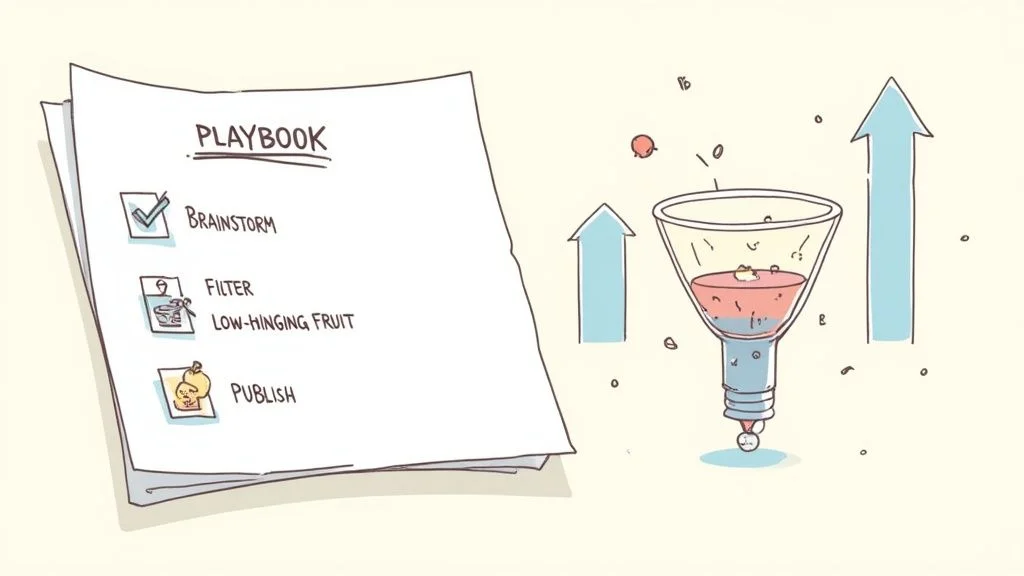
What Is Keyword Difficulty and How to Rank
Sections
Keyword difficulty is one of those core SEO metrics you hear about all the time. Put simply, it’s a score that tries to predict how hard it will be to rank on the first page of Google for a specific search term. Most tools use a scale from 0 to 100, where a higher number means you’re up against some seriously tough and authoritative competitors. Think of it as a strategic forecast before you dive headfirst into creating content.
#Understanding Keyword Difficulty Without the Jargon

Let’s try a real-world analogy. Imagine you want to open a new coffee shop. Before you even think about signing a lease, you’d walk the neighborhood, right? You’d check to see if you’re competing against a dozen established cafes on a busy street or if you’d be the only game in town in a new development.
Keyword difficulty is the digital version of scouting that neighborhood. It helps you size up the competition before you invest your time, money, and energy into writing a blog post or creating a landing page. It’s not just about how many people are searching for a term; it’s about the strength of the websites you’d have to beat.
#What Goes Into a Keyword Difficulty Score?
So, how do SEO tools actually come up with this number? At its heart, a KD score is a prediction based on what’s already ranking on page one. The tool looks at the top results and evaluates a whole bunch of factors.
When a tool analyzes a keyword, it’s essentially checking the “digital résumés” of the top 10 results on Google. It’s asking questions like:
-
How many high-quality “references” (backlinks) do these pages have?
-
What’s their overall “career experience” (domain authority)?
-
How well do their “skills” (on-page SEO) match the job (the search query)?
To give you a clearer picture, here are the main ingredients that typically go into a keyword difficulty score.
#Key Factors Influencing Keyword Difficulty Scores
This table breaks down the primary components that SEO tools analyze to calculate a keyword difficulty score.
| Factor | What It Means | Why It Matters |
|---|---|---|
| **Backlink Profile** | The number and quality of links pointing to the ranking pages. | Backlinks are like votes of confidence. More links from strong, relevant sites signal higher authority to Google. |
| **Domain Authority (DA/DR)** | A score predicting a website's overall strength and likelihood to rank. | Competing against sites with high authority is much harder, as they are already trusted by search engines. |
| **Content Relevance** | How well the content on the page matches the searcher's intent. | Google wants to show the most helpful answer. Highly relevant, comprehensive content has a major advantage. |
| **On-Page SEO Signals** | How well a page is optimized, including titles, headings, and keyword usage. | Strong on-page SEO tells Google exactly what a page is about, making it easier to rank for the right terms. |
| **SERP Features** | The presence of features like video carousels, featured snippets, or ad packs. | These features can push organic results further down the page, making it harder to get clicks even if you rank well. |
By looking at the collective strength of these top pages, the tool assigns that single score to summarize the challenge ahead. This is why you’ll see different scores from different tools - each one has its own secret recipe for weighing these factors.
But no matter the tool, the goal is always the same: to give you a solid estimate of the effort it’s going to take. This metric is a cornerstone of good SEO, and getting comfortable with terms like domain authority and backlinks is key. For a deeper dive, check out our comprehensive glossary of SEO terms.
#Why Keyword Difficulty Is Your Strategic Advantage

Knowing what keyword difficulty is is one thing. Using it as a strategic compass for your entire SEO plan? That’s where the real power is. Ignoring this metric is like trying to climb Mount Everest in flip-flops - sure, you’re ambitious, but you’re setting yourself up for a painful reality check.
Keyword difficulty is what turns SEO from a guessing game into a series of calculated, intelligent moves. It helps you decide where to spend your most valuable resources: your time, your budget, and your team’s creative energy.
Instead of burning months chasing a keyword dominated by global brands, you can find the terms where you actually have a fighting chance. It’s the difference between charging into a battle you can’t win and strategically capturing valuable ground.
#Prioritize Efforts for Maximum Impact
Think of keyword difficulty as your roadmap for what to create and when. By going after terms you can realistically rank for, you build a foundation of steady, incremental wins. It’s all about building momentum.
Here’s a simple way to look at it:
-
Low-Difficulty Keywords: These are your quick wins. They get you on the scoreboard fast, driving some initial traffic and building your website’s authority. Every win makes you stronger for the next fight.
-
Medium-Difficulty Keywords: Once you’ve built up some authority, these are your next targets. They take more work but bring bigger rewards in traffic and visibility.
-
High-Difficulty Keywords: These are the long game. You can tackle these once your site is a recognized player in your niche, backed by all the authority you built from your earlier wins.
#Build Authority and Sidestep the Giants
For any new or smaller website, targeting low-competition keywords isn’t just a good idea - it’s the only way to play.
Imagine a brand-new blog trying to rank for “running shoes.” They’d be up against giants like Nike and Runner’s World. The keyword difficulty score would immediately flash a warning sign, telling them it’s a losing fight.
But what if that same blog targeted “best running shoes for flat feet beginners”? This long-tail keyword has a much lower difficulty score. It allows the new site to gain a foothold, pull in a super-specific audience, and start building its reputation. This is how smart marketers sidestep the giants and build real authority from the ground up.
By focusing on achievable keywords first, you create a positive feedback loop. Ranking for easier terms brings traffic, earns backlinks, and signals to Google that your site is a credible source. This accumulated authority is what lets you compete for the tougher keywords later on.
This layered approach - from easy wins to ambitious goals - is the heart of a sustainable SEO strategy. It ensures every piece of content you create moves you forward. To take this even further, check out how an Opportunity Score can help maximize your SEO chances, which pairs perfectly with this kind of analysis.
Ultimately, keyword difficulty isn’t just a number; it’s your guide to smart, efficient growth.
#How SEO Tools Calculate Keyword Difficulty
Ever wondered what’s going on under the hood when your favorite SEO tool spits out a keyword difficulty score? It’s not magic, it’s a lightning-fast analysis of the battlefield you’re about to enter - Google’s first page.

Think of it like this: each of the top-ranking pages has its own “digital resume.” SEO tools act like a hiring manager, instantly scanning the resumes of all the top candidates to gauge their collective strength. They aren’t just looking at one page’s credentials, but the combined power of everyone already holding a top spot.
These algorithms are built to measure the authority and relevance of the pages that are already winning. That’s why getting a handle on what is keyword difficulty really means understanding what these tools are seeing on the search engine results page (SERP).
#The Core Ingredients of a KD Score
While every tool guards its secret recipe, they all tend to look at the same core ingredients when judging a page’s digital resume. These are the main signals that get rolled up into that final difficulty score.
-
Backlink Profiles: This is like checking references. The algorithm zips through the backlink profiles of the top-ranking pages, counting not just the number of links but - more importantly - their quality. A page with a ton of links from trusted, high-authority sites has a glowing set of references, making it incredibly tough to outrank.
-
Domain Authority: This is the “career experience” of the entire website. A high domain authority signals that the site is a well-established and trusted voice in its industry. This reputation gives all of its pages a leg up on the competition.
-
Content and On-Page Factors: This is all about the “skills” listed right on the resume. The tool scans how well the content is optimized for the keyword, its overall quality and depth, and how relevant it is to what the user is searching for.
By crunching all this data from the top 10 or 20 results, the tool gives you a single, easy-to-understand score that sizes up the competition. For those in competitive niches, digging into the best SEO tools for agencies can offer a much deeper look into these calculations.
#Understanding Page Strength and Its Impact
Some of the more sophisticated tools go even deeper, using broader metrics to measure a page’s raw ranking power. One of the best ways to think about this is the concept of Page Strength, which wraps up a URL’s total ranking ability by combining everything from its backlink profile and content quality to its historical performance in the SERPs.
This approach gets it right: ranking isn’t about acing one single factor, but about the sum of all its parts. The combined strength of the pages already at the top directly determines how hard it will be for a new page to crack the list.
In fact, research from seoClarity’s database of over 500 million keywords shows a clear link between the Page Strength of the top-ranking URLs and how difficult it is for new content to break in. This data-driven insight proves why it’s absolutely critical to analyze the authority of the pages you’re up against. You can get more details from their extensive research on calculating keyword difficulty.
This whole process is also why KD scores aren’t universal. Every tool has its own unique way of reading these digital resumes, which explains why the numbers can vary from one platform to the next.
#Comparing Keyword Difficulty Scores Across Top SEO Tools
If you’ve ever plugged the same keyword into Semrush, Ahrefs, and Moz, you’ve probably scratched your head a bit. One tool says a keyword has a difficulty of 45, while another is convinced it’s a 60. What gives?
This doesn’t mean one tool is “right” and the others are “wrong.” It just means they’re all interpreting the competitive landscape through a slightly different lens. Each platform uses its own secret sauce - a proprietary algorithm, a unique backlink database, and its own way of weighing different ranking factors.
Think of them like different scouts sizing up a football team. One scout might be obsessed with the quarterback’s passing stats (backlinks), while another puts more stock in the team’s overall season record (domain authority). Both are looking at the same game, but they’re focusing on different data points, leading them to different conclusions.
Because of this, you can’t just grab a KD score and run with it. The number itself is far less important than what it tells you within the context of that specific tool.
#Why the Scores Are Different
So, what’s happening under the hood? The main reason for the score differences comes down to how each platform measures authority and analyzes the search results page (SERP).
Some tools have a much larger index of backlinks, giving them a more comprehensive (or at least different) view of a page’s link profile. Others might lean more heavily on a domain’s overall power instead of the specific strength of the page that’s ranking.
Here’s a quick breakdown of what drives these variations:
-
Backlink Database Size: A tool with a bigger backlink index might spot more “votes of confidence” for a ranking page, which can nudge the difficulty score higher.
-
Authority Metrics: Every platform has its own flagship authority score, like Domain Authority or Domain Rating. The way they calculate and factor this into their KD formula can vary wildly.
-
SERP Analysis: Some tools might analyze the top 10 results, while others look at the top 20. They also weigh on-page signals differently in their calculations.
And while we’re talking about comparing scores, it’s worth noting that the industry is always evolving. New types of AI visibility metrics software are popping up, offering fresh perspectives on search performance.
The key takeaway is this: Keyword difficulty is a relative compass, not an absolute truth. A score of 50 in Ahrefs is meant to be compared to other scores in Ahrefs, not pitted directly against a 50 from Moz.
#A Look at Semrush and Its Unique Approach
Many tools are also working to make their metrics more personal and actionable. Semrush, for example, not only grades keyword difficulty on a standard 0% to 100% scale but has also rolled out a clever feature called Personal Keyword Difficulty (PKD).
This metric doesn’t just look at the SERP in a vacuum. Instead, it analyzes your own website’s authority to estimate how hard a keyword would be for you to rank for. It’s a game-changer for finding those hidden gems that might look tough on paper but are actually well within your reach. You can discover more insights about their approach on Semrush.com.
#Keyword Difficulty Metrics Comparison Semrush vs Ahrefs vs Moz
To make sense of these differences, it helps to see how the big players stack up. Here’s a quick comparison of how Semrush, Ahrefs, and Moz calculate and present their difficulty scores.
| SEO Tool | Metric Name | Score Range | Key Differentiator |
|---|---|---|---|
| **Semrush** | Keyword Difficulty | 0-100% | Also offers **Personal Keyword Difficulty (PKD)**, which customizes the score based on your domain. |
| **Ahrefs** | Keyword Difficulty | 0-100 | Heavily based on the **backlink profiles** of the top-ranking pages. |
| **Moz** | Keyword Difficulty | 0-100 | Blends **Page Authority (PA)** and **Domain Authority (DA)** of the top results. |
Ultimately, getting stuck on the exact number is a rookie mistake. The real power comes from using the score within your chosen tool to compare the relative difficulty between keywords on your list. This simple shift in perspective turns a potentially confusing number into a seriously effective strategic guide.
#Putting Keyword Difficulty into Action

Alright, so you understand what keyword difficulty scores are. That’s the first step. But the real magic happens when you start putting that knowledge to work. This metric isn’t just another number on a spreadsheet; it’s a powerful filter that should shape your entire content workflow, from brainstorming all the way to hitting “publish.”
Essentially, KD helps you cut through the noise. It turns a massive, overwhelming list of potential keywords into a clear, actionable roadmap. The core idea is to match the keywords you target with your website’s current strength. A brand-new blog and an established industry titan are playing two completely different games, and KD helps you pick the right battles at the right time.
#Finding Your Low-Hanging Fruit
The quickest and most effective way to use keyword difficulty is to hunt for “low-hanging fruit.” These are the keywords that your audience is searching for and have a low enough KD score for your site to actually rank for them - and soon.
For a newer site with low authority, this might mean focusing on keywords with a KD under 20. A more established site, on the other hand, might see anything under 40 as a golden opportunity.
Here’s a simple way to sift through your keyword list to find these gems:
-
Export Your Keywords: Grab that big list of potential keywords you’ve gathered.
-
Sort by Difficulty: This is the most important step. Sort the entire list by the KD score, from lowest to highest.
-
Apply a Volume Filter: To make sure you’re not chasing ghosts, filter out keywords with zero traffic. A minimum of 50 monthly searches is a good starting point.
-
Prioritize and Plan: What’s left is your priority list. These are achievable topics that can start pulling in traffic and building your site’s authority right away.
This systematic approach is a game-changer for any site trying to gain traction. For a deeper dive, our guide on how to find low-competition keywords walks you through the entire process.
By consistently targeting and ranking for these achievable keywords, you start building momentum. Think of each ranking as a small win that adds to your site’s overall authority, making it that much easier to go after the bigger, more competitive terms down the road.
#Balancing Your Content Portfolio
A winning SEO strategy is never about just one type of keyword. It’s like a smart investment portfolio; you need a healthy mix of safe bets and more ambitious, long-term plays. Keyword difficulty is the perfect tool for creating that balance.
Think of it in baseball terms:
-
Base Hits (Low KD): This should be the bulk of your content, especially when you’re starting out. These are your reliable traffic drivers that keep the scoreboard ticking and your site growing steadily.
-
Doubles (Medium KD): As your site’s authority climbs, you can start swinging for keywords with moderate difficulty. They take more effort to rank for, but the traffic payoff is bigger.
-
Home Runs (High KD): Save a small slice of your resources for the big, high-difficulty, high-volume topics. These are your pillar pieces - long-term projects that might take a year or more to rank but can completely transform your business if you connect.
When you structure your content plan this way, you ensure a steady flow of traffic from your base hits while you’re simultaneously working on the high-reward home runs that will define your success in the long run.
#Answering Your Questions About Keyword Difficulty
Alright, you’ve got the basics down. But when you actually start using keyword difficulty to build your content plan, some tricky questions always pop up. Getting these nuances right is what separates a good strategy from a great one.
Let’s dive into the most common questions we see and give you some clear, straightforward answers. The goal here is to help you use this metric with confidence, avoid the common pitfalls, and make smarter choices right from the start.
#What Is a Good Keyword Difficulty Score for a New Website?
For a brand-new website with little to no authority, the name of the game is momentum. You have to focus your energy where you actually have a shot at winning.
A great place to start is by targeting keywords with a low difficulty score - typically under 30 on most tools that use a 0-100 scale. There’s a reason people call these “low-hanging fruit.” They give you a realistic chance to get on the board, earn those first few organic clicks, and start signaling to Google that you’re a credible source.
As your site builds up a history and earns some backlinks, you can gradually start aiming for keywords with higher scores.
#Should I Ignore High Keyword Difficulty Keywords Completely?
No, absolutely not. High-difficulty keywords shouldn’t be your main focus when you’re just starting out, but ignoring them completely is a mistake. Why? Because they are often the most valuable terms in any niche, usually boasting massive search volume and high commercial intent.
Think of them as long-term “stretch goals,” not immediate targets.
A much smarter approach is to build a foundation around them. Here’s how that works in practice:
-
Pick your high-KD “pillar” keyword: This is your big, ambitious target (let’s say, “digital marketing”).
-
Create an amazing pillar page: Build a comprehensive, in-depth resource that covers the topic from top to bottom.
-
Support it with “cluster” content: Write a series of smaller articles that target lower-difficulty, related long-tail keywords (like “digital marketing for small business” or “best social media marketing tools”).
As your cluster content starts to rank over time, it passes authority and relevance back to your main pillar page. This strategy lets you use the authority you’ve earned from easier wins to eventually compete for the much tougher, high-value keyword.
Keyword difficulty isn’t a stop sign; it’s a yield sign. It’s just telling you to proceed with caution and have a solid plan before you try to merge into high-speed traffic.
#Is Keyword Difficulty the Only Metric I Should Use?
This is a critical point, so listen up: keyword difficulty should never be used in isolation. It’s just one piece of a much larger puzzle. Relying on it alone is a recipe for a weak strategy.
A truly successful keyword plan requires a balanced view of several key metrics. You need to find terms that are not just achievable, but also valuable for your business.
Always analyze KD alongside these other factors:
-
Search Volume: This tells you the size of the prize. A keyword might be easy to rank for, but if nobody is searching for it, it’s not going to drive any results.
-
Search Intent: This is all about understanding what the user really wants. Are they looking to buy something, learn information, or find a specific website? Your content has to match their intent, period.
-
Relevance: How closely does this keyword actually align with your business, your products, or your services? Ranking for an irrelevant term just brings the wrong kind of traffic.
The winning keywords are always found in the sweet spot: achievable difficulty, decent search volume, and a perfect match for both user intent and your business goals.
Ready to stop guessing and start targeting the right keywords? Rankdigger’s Search Analytics tool helps you uncover high-potential keywords with its unique Opportunity Score, turning complex data into a clear, actionable roadmap. See how it works.

